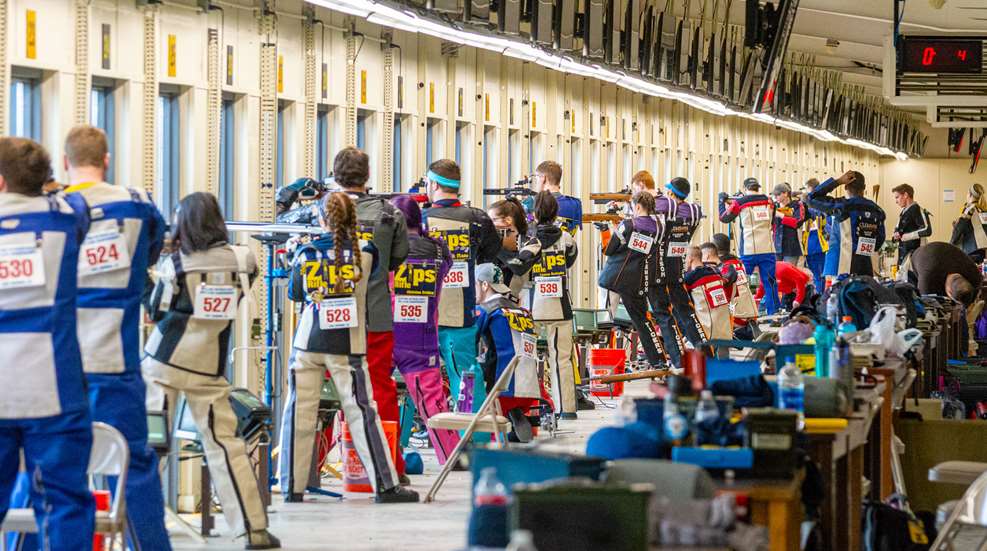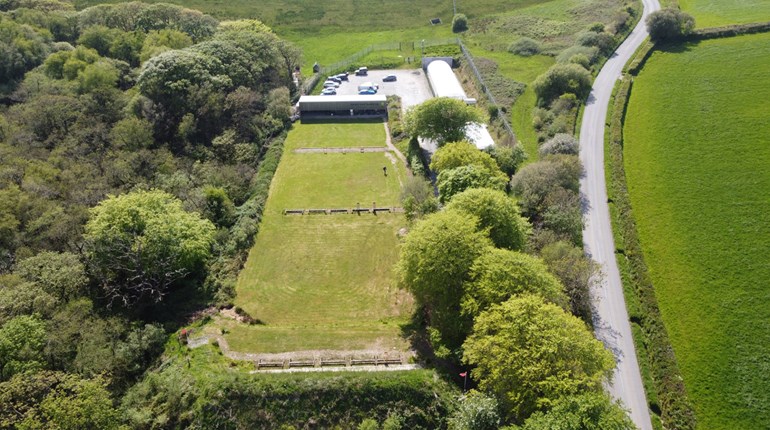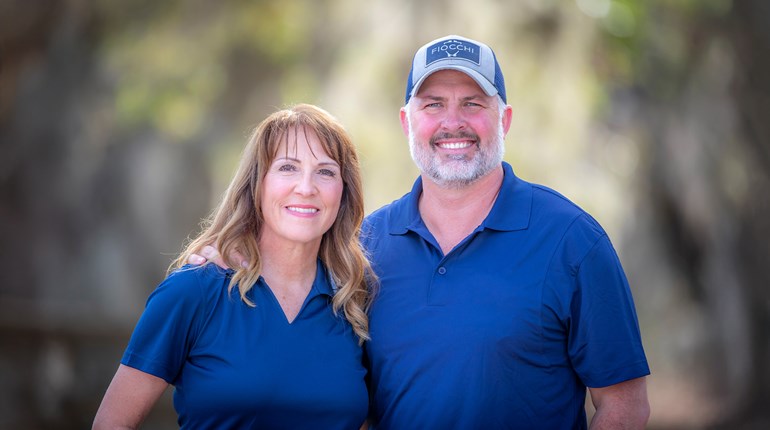
Having a suitable place to shoot is the first step in planning a collegiate competitive shooting program. The location may be as informal as a temporary air gun range set up in an empty classroom, or as elaborate as an indoor or outdoor facility that can accommodate any number of shooting disciplines.
Many schools have suitable indoor ranges for smallbore rifle, smallbore pistol and air gun. Some ranges may still be under a school's ROTC department, or in disuse because many were built decades ago to meet ROTC requirements. Over the years, a number of schools discontinued their cadet programs and others dropped marksmanship as a mandatory requirement. As a result, some range facilities may be used for shooting, but others may have been adapted for other campus uses.
While extremely popular, shotgun competition is limited to outdoor facilities which demand a relatively large amount of space. For this reason, many collegiate shotgun programs share trap or skeet fields with community organizations. Some universities, like Hillsdale College, are expanding ranges to accommodate student-athletes in the shooting sports.
Some collegiate shooting programs complement on-campus facilities by gaining permission to use ranges at nearby military posts, National Guard armories, local high schools, private shooting clubs, YMCAs or local community centers. Here, too, the National Rifle Association or a state rifle and pistol association may help in finding a suitable range close to campus.
An air gun range can be set up anywhere, provided there is a safe backstop. This range can be set-up in a classroom, gymnasium or even on a shooting range. The easy set-up and take-down of an air gun range allows the room to be multi-purpose and go from classroom setting to shooting range and back to classroom.
Specific information on ranges for each sport included in the campus program is available from the NRA, including outdoor ranges for high power, silhouette and pistol, indoor ranges and shotgun fields. NRA range materials include information on zoning and local ordinances and the evaluation of safety, environmental and construction problems. Range regulations for each discipline are suggested. These regulations demonstrate to school authorities that the program is serious, will run safely and that those who participate in any sanctioned shooting activity will follow safe and sound procedures.
If a range exists on campus, find out who maintains it. The proposed program may be allowed to share available range time. On the other hand, if the range is closed, learn the reasons why. If the cause was due to technical problems, such as faulty ventilation or equipment, contact the NRA Range Development Program for information, help and support.
Planning based on the type of program
Intramural
Most intramural sports are conducted over a short period of time, such as a month, so that enthusiasm and interest among student-athletes remains high throughout the activity.
Available facilities are the key.Choosing the most appropriate shooting discipline for a school's intramural activity depends to a great degree on the same considerations necessary for competitive programs. Available facilities are the key. If a campus has an existing indoor range or easy access to a shotgun field, the choice is almost already made for you. Factor in the student and instructor interests, and the most appropriate courses will almost select themselves.
Virtually the same facilities and equipment necessary for a successful competitive program will be required for a physical education course or intramural activity. Intermediate-grade air guns are accurate, and are probably best adapted in weight and size for beginning shooters—the category of most intramural participants.
An intramural shooting program may be organized much like any other intramural sport. Most intramural sports operate on an elimination system that includes several rounds of competition over several weeks or months. It is recommended that at the shooting event the students fire one, two or three times with shoot-offs at the end to determine the individual and team winners. Teams can be formed within each category level to establish a winner, with an end-of-season tournament matching the top teams from each category for naming an overall champion. Although shooting is an exciting sport to many, it is not considered a real spectator sport. Interest could be lost if participants were to shoot over a longer period of time.
It is important to schedule instruction for safety rules and handling of the guns, regardless of a student's familiarity with guns. These safety precautions and procedures are mandatory for any marksmanship course. They also add a visible safety image for all students to identify with during the competition.
Competition
Whether the program is intercollegiate, varsity, club or simply intramural in nature, understanding the mechanics of competition is important. If the proposed program is to join an existing league or conference, the league's organization and operating procedures must be learned and described in the program proposal. If, on the other hand, the new program is expected to travel and compete with other schools, more preparation is needed.
In considering league or conference competition, there should be a governing body or council to establish rules ensuring the operation of the competition. Bylaws should be written to address such matters as membership qualifications, organizational committees, rules for match scheduling, penalties and processes for enforcing the rules, etc. Matters such as awards and courses-of-fire are determined by the council and should be outlined in the bylaws.
By affiliating a program with the NRA and by adhering to NRA rules for each shooting discipline, competitors may participate in the NRA classification system. By doing so, they will have no trouble adapting to shooting competitions throughout the nation, on the collegiate level, as well as at the national competitive level. Competitive shooters will have a variety of skill levels. The shooting sports place a great emphasis on ensuring that every participant is challenged and encouraged to compete—regardless of his or her present skill level.
Handicapping is an important means of achieving universal participation. There are a variety of ways to handicap a competition, each designed to make shooting available, interesting and fun for all participants.
Good teams can be built from inexperienced shooters, but experienced coaches are needed.
Intercollegiate competition can be on varsity or club levels.As with any sport, varsity and club programs are similar in status in the structure of formal collegiate sports. In terms of organizational and competitive requirements, they are also similar. Each program forms around a nucleus of interested students and faculty. Coaches and team members must be recruited, training schedules established and matches coordinated.
Campus interest is a good way to determine whether the initial proposal to the school's administration should be to form a varsity or club competitive shooting program. Find out how many students would consider trying out for a club or team. Do they have any prior shooting experience? Was it informal plinking or actual competitive training?
If interest is strong and a number of students have considerable shooting experience, a varsity team may be a good idea. If there is a strong interest, but little shooting experience, consider the less formal club sport for a start.
Good teams can be built from inexperienced shooters, but experienced coaches are needed. The enthusiasm and skill of the coaches are critical for the success of any competitive shooting program. Coaches must be able to nurture the novice and mold a cohesive team.
When the time comes to convince the school administration that the proposed competitive shooting program is viable, you must provide realistic answers regarding travel and expenses, including the number of off-campus matches per season, destinations, the means of transportation, the time students will be required away from campus, food and lodging—and how the bills will be paid. This information is important from a scheduling standpoint and for budget planning.
Developing the skills of a top competitive shooter requires careful and continual practice, as well as physical conditioning. A well thought-out training schedule is vital to mastering marksmanship, and can strengthen team identity and morale.
See more: Introduction To Intercollegiate Competitive Shooting


































